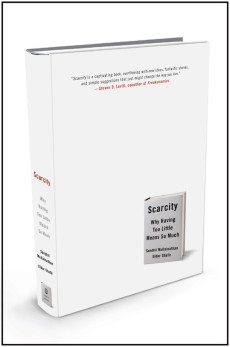
Scarcity: Why Having Too Little Means So Much
Sendhil Mullainathan and Eldar Shafir
304 pages, Times Books, 2013
Prepare to update your theory of change. Scarcity: Why Having Too Little Means So Much, a new book by Sendhil Mullainathan and Eldar Shafir, behavioral scientists at Harvard and Princeton respectively, opens new pathways to understand why it can be so hard to help people in need and some ideas on how to do it successfully.
Mullainathan and Shafir delve into the age-old question of why people in difficult circumstances tend to make objectively bad decisions. You can’t spend long among populations in extremis without noticing this troubling and frustrating pattern. For instance, poor households often do not save when they can, or they pass up what seem to be easy opportunities to save. This is not to say that the households aren’t often in situations where only bad options are available—but on those occasions when good options are available, those households often don’t take them.
At least part of the reason, Mullainathan and Shafir argue, is that conditions of scarcity affect how we think. When some resource is in short supply, the brain focuses on managing that resource. Unfortunately, that focus isn’t on managing the resource wisely over the long-term; it’s on finding the quickest way to deal with the immediate shortage. Thus, when a person is running low on cash, he can’t help but block out other issues and even long-term concerns in the leap to quick solutions. In other words, payday and title loans are even more tempting than we might have imagined. Importantly, the scarcity effect is similar no matter what the item in short supply is: Dieters focus on food, busy people focus on time, the lonely focus on relationships—all to the detriment of other concerns or long-term solutions.
There are plenty of good reviews of the book Scarcity out there (see The New York Review of Books, The Economist, and The Guardian, for instance), so I’ll focus on two important points for social entrepreneurship.
First, Scarcity provides a compelling argument for a wide variety of interventions. Even if a poor single mother can find a job and childcare, if that childcare is unreliable or untrustworthy, it will undermine her performance at work—and therefore her job security and future. The ability of a child to focus in school is limited by concerns over housing. The health of poor households is at risk not just because of the cost of care, but also because the very nature of poverty makes it difficult for them to focus on necessary health behaviors, even when the stakes are extremely high—amputation, blindness, or death (as is the case with diabetes).
While many have made these arguments for years to justify programs, Scarcity provides a sound scientific underpinning for the arguments that hasn’t existed before. More so, it bolsters them. The problem is worse than even many advocates have suggested. Befitting his role as an economist, Mullainathan particularly hones in on the need for quality financial services to address the attention, focus, and decision-making problems that a scarcity of money creates. But it’s easy to argue that we can address the problem from either direction. If poverty—here, defined narrowly as a lack of cash—makes it difficult to make sound decisions about housing, why not address the housing issue directly? It’s arguably easier to do than addressing the causes of lack of cash, which could be anything from the global macroeconomy to limited interpersonal skills. Equally, helping a poor household cope with other distractions and attention-traps may free up mental resources to allow it to make better financial decisions.
The mental processes that Scarcity describes should factor into the program design of many different interventions.
That leads to my second point: Scarcity provides a compelling argument for a wide variety of interventions—and no, that’s not an accidental repeat of the first point. Because underlying behavioral challenges caused by scarcity apply broadly to almost every social service, it makes it difficult to assess and prioritize those interventions. While the book helps shine a light on a vexing problem, from the perspective of allocating philanthropic dollars and effort, we are still at the starting line. Since we can attack the problems of scarcity in many, many ways, it’s difficult to use the insights of the book to choose which way to attack the problem.
All in all, this is an important book for any social entrepreneur thinking about poverty interventions. It should factor into program design and theories of change. But it’s not going to make the choices that donors, social investors, or foundation program officers face any easier.

